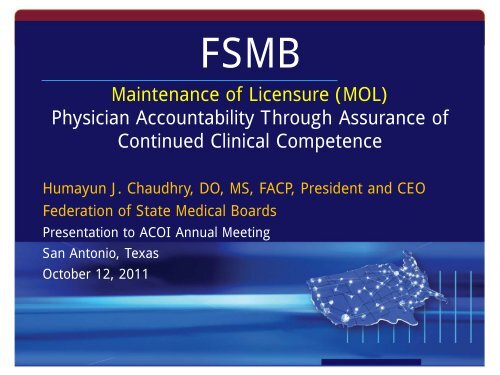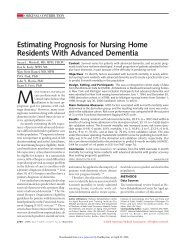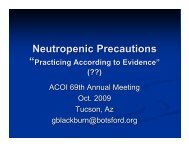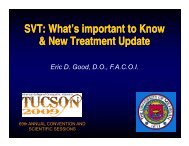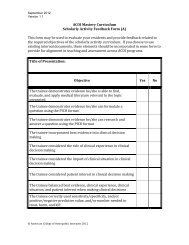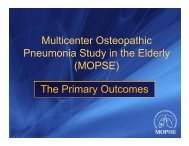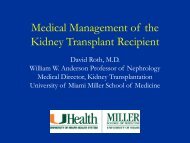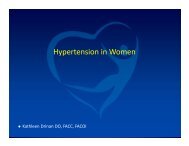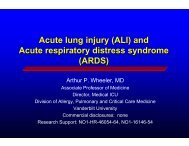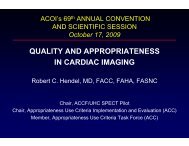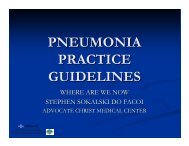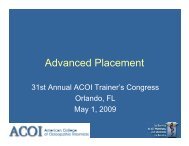Maintenance of Licensure - American College of Osteopathic Internists
Maintenance of Licensure - American College of Osteopathic Internists
Maintenance of Licensure - American College of Osteopathic Internists
You also want an ePaper? Increase the reach of your titles
YUMPU automatically turns print PDFs into web optimized ePapers that Google loves.
FSMB<strong>Maintenance</strong> <strong>of</strong> <strong>Licensure</strong> (MOL)Physician Accountability Through Assurance <strong>of</strong>Continued Clinical CompetenceHumayun J. Chaudhry, DO, MS, FACP, President and CEOFederation <strong>of</strong> State Medical BoardsPresentation to ACOI Annual MeetingSan Antonio, TexasOctober 12, 2011
Outline• FSMB– History, Vision, Mission– Current Activities• <strong>Maintenance</strong> <strong>of</strong> <strong>Licensure</strong> (MOL)– Background and Rationale– Relationship to <strong>Maintenance</strong> <strong>of</strong> Certification (MOC)and <strong>Osteopathic</strong> Continuous Certification (OCC)– From Framework to Implementation• Q & A2
Federation <strong>of</strong> State Medical Boards (FSMB)• Established in 1912, headquartered in Texas with anadvocacy <strong>of</strong>fice in Washington, D.C. since 2010• Represent and support all 70 state medical andosteopathic boards <strong>of</strong> the U.S. and its territories• Co-own, with the NBME, the USMLE• Secretariat, International Association <strong>of</strong> Medical RegulatoryAuthorities (IAMRA)• Journal <strong>of</strong> Medical Regulation, since 1915• Board Chair: Janelle Rhyne, MD, MACP3
5Greetings from FSMB Board ChairJanelle Rhyne, M.D., MACP
Greetings from the FSMB Board <strong>of</strong> Directors6
FSMB Organizational Chart70 Member BoardsBoard <strong>of</strong> DirectorsTodd Phillips, MBAChief Financial OfficerExecutive OfficeHumayun Chaudhry, DO, FACPPresident and CEOSandra Waters, MEMChief Operating OfficerMichael Dugan, MBAChief Information OfficerLisa Robin, MLASenior Vice PresidentAdvocacy and MemberServices7© 2010 Federation <strong>of</strong> State Medical Boards
8Launch <strong>of</strong> FSMB’s Washington, D.C. OfficeOffice
Federation Credentials Verification Service (FCVS)• Primary source verifies/stores core credentials:– Identity <strong>of</strong> Physicians and PAs– Undergraduate Medical and Graduate Medical Education– Medical Specialty (ABMS Certification)– State Medical and <strong>Osteopathic</strong> Board Actions– Medical <strong>Licensure</strong> Examination Results• Established in 1996, FCVS is:– Accepted by 63 <strong>of</strong> 69 state medical boards– FCVS contains pr<strong>of</strong>iles for more than 135,000+ physicians9
Uniform Application for Physician State<strong>Licensure</strong> (UA)• State board consensus on common dataelements• Promotes standardization• Eliminates redundancy• Promotes paperless environment• Persistence for docs; backup for boards• One-stop for subsequent licensureapplications10© 2010 Federation <strong>of</strong> State Medical Boards
Physician Data Center• Board Action Data Bank• Collects & reports data on disciplinary actions takenagainst physicians and physician assistants bymedical boards and other authorities• Querying –www.drdata.org• Annual Data Compilation Release• All Licensed Physicians Information• Consolidated physician information• Disciplinary Alert Service• Public access – www.docinfo.org11© 2010 Federation <strong>of</strong> State Medical Boards
2010 FSMB Census <strong>of</strong>Licensed Physicians inthe United StatesPrepared by: Aaron Young, Ph.D.Senior Director, Research and AnalyticsFederation <strong>of</strong> State Medical Boards
13Why is an understanding <strong>of</strong> the supply<strong>of</strong> licensed physicians critical?• Growth <strong>of</strong> the U.S. population– Population growth by 60 million to a total <strong>of</strong> 373 million by 2030• Aging <strong>of</strong> the population– Baby boomers started turning 65 in 2011, and each day for the next19 years an estimated 10,000 boomers will reach age 65– Individuals 65 and older typically use more health services• Health Care Reform and the Affordable Care Act (ACA)– An additional 32 million <strong>American</strong>s may be insured under the new lawby 2019
14Findings from the 2010 FSMB Census• There are 850,085 physicians with an active medical license in the U.S.and District <strong>of</strong> Columbia, as <strong>of</strong> November 30, 2010– 93% are MDs and 7% are DOs– Graduated from 1,926 medical schools in 161 countries– 76% graduated from a U.S. or Canadian medical school– Of the 188,402 international medical graduates (IMGs): India (23%),Philippines (8%), Pakistan (5%), Mexico (5%) and Grenada (3%)• 17% <strong>of</strong> physicians have two active licenses and 6% have three or more• ABMS Certification– 75% <strong>of</strong> physicians were certified by at least one ABMS specialty board– U.S. grads more likely than IMGs to have it (77% vs. 70%)– Physicians with board certification from an ABMS board more likely to have twoor more active state licenses (25% vs. 17%)
15FSMB House <strong>of</strong> Delegates, 2010
The Re-Emerging Concern• In 1995, the Pew Charitable Trust Health Pr<strong>of</strong>essionsCommission recommended that states “require eachlicensing board to develop, implement and evaluatecontinuing competency requirements to assure thecontinued competence <strong>of</strong> regulated health carepr<strong>of</strong>essionals.”• In 1999, the Institute <strong>of</strong> Medicine (IOM) said thatconsumers generally believe they are protected within thehealth care arena because “licensure and accreditationconfer, in the eyes <strong>of</strong> the public, a ‘Good HousekeepingSeal <strong>of</strong> Approval,’ and suggested greater assessment <strong>of</strong>physicians’ performance <strong>of</strong> skills after initial licensure.”16
The Re-Emerging Concern• In 2001, the Institute <strong>of</strong> Medicine (IOM) said that in apr<strong>of</strong>ession with “a continually expanded knowledgebase,” a mechanism was needed to ensure thatpractitioners remain up to date with current bestpractices. It also noted that medical regulation, whenproperly conceived and executed, “can both protect thepublic’s interest and support the ability <strong>of</strong> health carepr<strong>of</strong>essionals and organizations to innovate and changeto meet the needs <strong>of</strong> their patients.”17
The Compelling Evidence• Kimmel studied 19,000 PTCA patients and, afteradjusting for case mix, found an inverse associationbetween cardiac catheterization lab procedure volumeand major complications (1995)• Choudhry’s systematic review <strong>of</strong> clinical experience andhealth care quality found that physicians in practicelonger may be at risk for providing lower-quality care(2005)• Age-related cognitive decline, impairment due tosubstance use disorders and other psychiatric illness maycontribute to underperformance, diminishing physicians’insight into their level <strong>of</strong> performance (Williams, 2006)18
FSMB’s Special Committee on MOL• Special Committee on <strong>Maintenance</strong> <strong>of</strong> <strong>Licensure</strong>established in 2003 by FSMB Chair Thomas Kirksey, M.D.– Develop policy recommendation, strategies forimplementation• Composition– SMB representatives– Consultants (ACCME, NBME, ABMS)• Input received from– Physician advocacy groups (AOA, AMA)– Public bodies (IOM, Pew Health Pr<strong>of</strong>essions Commission)– Certifying agencies (AOA-BOS, ABMS)– Accrediting bodies (Joint Commission, ACCME)19
FSMB House <strong>of</strong> Delegates2004 Policy Statement“ State medical boards have aresponsibility to the public toensure the ongoing competence<strong>of</strong> physicians seeking relicensure.”20
Special Committee Report – 2008MOL Model Policy Recommendations21• Provide evidence <strong>of</strong> competence within scope <strong>of</strong>pr<strong>of</strong>essional practice– Self-assessment/self-reflection (CPD)– Competence across “6+1” core areas• Patient care• Medical knowledge and skills• Pr<strong>of</strong>essionalism• Interpersonal and communications skills• Practice-based learning and improvement• Systems based practice• <strong>Osteopathic</strong> principles– Performance in practice
MOL Guiding Principles(adopted 2008; modified 2010)22• Support commitment to lifelong learning,facilitate improvement in physician practice• SMBs should establish MOL requirements; shouldbe administratively feasible, developed incollaboration with other stakeholders• MOL should not compromise patient care orcreate barriers to physician practice• Flexible infrastructure with variety <strong>of</strong> options formeeting requirements• Balance transparency with privacy protections
Advisory Groupon the Continued Competency <strong>of</strong> LicensedPhysicians (2009)J. Lee Dockery, MD, Chair Peter Katsufrakis, MD23Sue AndersonJohn Becher, DOAlice Coombs, MDClaudette Dalton, MDRichard Hawkins, MDNancy Kerr, RNDorothy Keville, MEdWilliam S. Mayo, DOJanelle Rhyne, MDSteven Stack, MD
FSMB Advisory Group:MOL Framework <strong>of</strong> 2010• Provide evidence <strong>of</strong> participation in a program <strong>of</strong>pr<strong>of</strong>essional development and lifelong learningbased on the 6 general competencies• 3 main components:– 1.) Reflective self-assessment– 2.) Assessment <strong>of</strong> knowledge and skills– 3.) Performance in practice• Goals, strategies and options/examples foreach <strong>of</strong> the 3 main components24
25Advisory Group: MOL FrameworkGOALReflective OPTION/EXAMPLESself-assessmentAssessment <strong>of</strong> knowledge and skillsPerformance in practiceSTRATEGY (HOW)• External measures <strong>of</strong> knowledge,skills, performance• Structured, valid, practice relevant• Produce data to identify learningopportunities• Incorporates data to assessperformance in practice and guideimprovement• Self-review tests–MOC/OCC–Home study–Web-based–Medical society•Others approved–Review <strong>of</strong> literature–CME•Practice-relevant MCQ exams (e.g.,MOC/OCC)•Standardized patients•Computer-based case simulations•Patient and peer surveys•Performance improvement CME &projects (SCIP, AMI, IHI, HEDIS)•Procedural hospital privileging•Others approved by SMBs•360 o evaluation•Patient reviews•Analysis <strong>of</strong> practice data•AOA CAP•ABMS MOC IV•CMS measures•Other performance projects
26MOL Implementation Group MeetingChicago, Illinois
WAMOL Pilot StatesMEORIDMTNDSDMNWIMINYVT-MVT-OCTMANHCA-ONVCA-MAZUTWYNMCONEKSOK-MOK-OIAMOARILINTNKYOHPAMDWVVANCSCNJDERIMSALGATXLAAKFLUS Virgin IslandsSTATE BOARDSHI= Participating27GUAs <strong>of</strong> 6-1-11
Richard Whitehouse, JDCEO Advisory Council28Accreditation Council for ContinuingMedical EducationAccreditation Council for GraduateMedical EducationAdministrators in Medicine<strong>American</strong> Association <strong>of</strong> <strong>College</strong>s <strong>of</strong><strong>Osteopathic</strong> Medicine<strong>American</strong> Board <strong>of</strong> MedicalSpecialties<strong>American</strong> Medical Association<strong>American</strong> <strong>Osteopathic</strong> Association<strong>American</strong> <strong>Osteopathic</strong> Association –Bureau <strong>of</strong> <strong>Osteopathic</strong> SpecialistsAssociation <strong>of</strong> <strong>American</strong> Medical<strong>College</strong>sCitizen Advocacy CenterCouncil <strong>of</strong> Medical Specialty SocietiesEducational Commission for ForeignMedical GraduatesNational Board <strong>of</strong> Medical ExaminersNational Board <strong>of</strong> <strong>Osteopathic</strong> MedicalExaminers
MOL Implementation Group’s Suggestions• MOL should be phased in - one component at a time -after a period <strong>of</strong> education and communication in the state• Periodicity <strong>of</strong> MOL for doctors should be every 5-6 years• The state medical/osteopathic board should establish theMOL requirements and processes for its physicians– FSMB will provide a template, support, services– OCC (like MOC) should substantially count for MOL– Need options for non-certified, non-MOC/OCC physicians– FSMB and NBME, NBOME, ABMS and AOA-BOS– MOL Workgroup on Non-Clinical Physicians29
30AOA-BOS, ABMS, NBME, FSMB, NBOME
1 st International MOL/Revalidation MeetingLondon, December 1-2, 201031
• 100 th Annual Meeting <strong>of</strong> the FSMBFort Worth, TexasApril 26-28, 201232
ContactHumayun J. Chaudhry, DO, FACPPresident and CEOFEDERATION OF STATE MEDICAL BOARDS400 Fuller Wiser Road, Suite 300Euless, TX 76039Tel: 817.868.4000 • Fax: 817.868.409733© 2010 Federation <strong>of</strong> State Medical Boards


